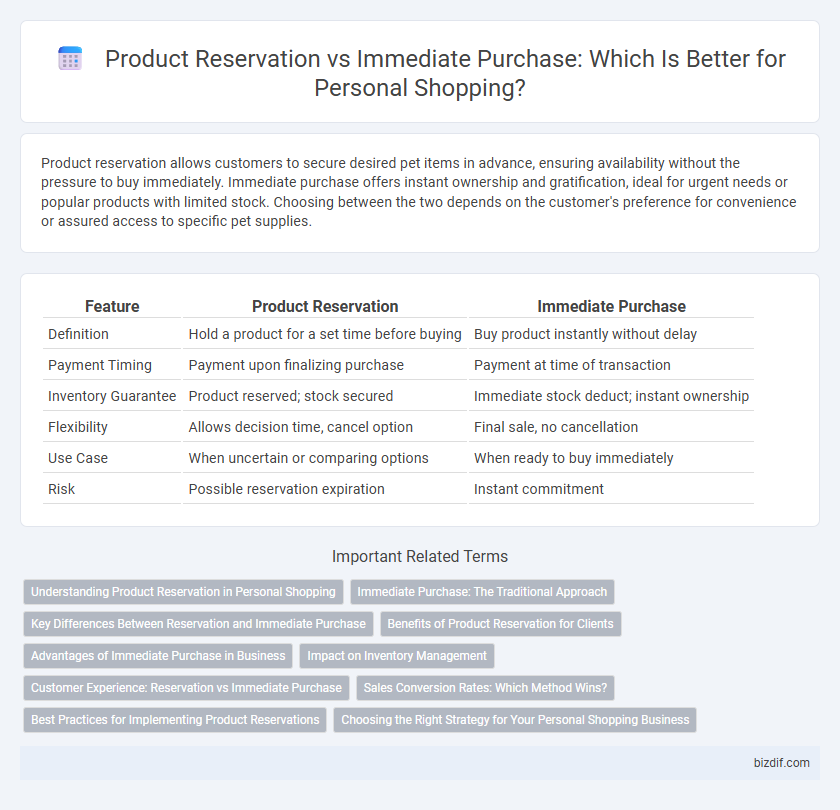Product reservation allows customers to secure desired pet items in advance, ensuring availability without the pressure to buy immediately. Immediate purchase offers instant ownership and gratification, ideal for urgent needs or popular products with limited stock. Choosing between the two depends on the customer's preference for convenience or assured access to specific pet supplies.
Table of Comparison
| Feature | Product Reservation | Immediate Purchase |
|---|---|---|
| Definition | Hold a product for a set time before buying | Buy product instantly without delay |
| Payment Timing | Payment upon finalizing purchase | Payment at time of transaction |
| Inventory Guarantee | Product reserved; stock secured | Immediate stock deduct; instant ownership |
| Flexibility | Allows decision time, cancel option | Final sale, no cancellation |
| Use Case | When uncertain or comparing options | When ready to buy immediately |
| Risk | Possible reservation expiration | Instant commitment |
Understanding Product Reservation in Personal Shopping
Product reservation in personal shopping allows customers to secure items without immediate payment, ensuring availability and time to make informed purchasing decisions. This method reduces the risk of missing out on limited-stock products while offering flexibility for budget planning and comparison. Immediate purchase guarantees instant ownership but lacks the advantage of holding products before final commitment.
Immediate Purchase: The Traditional Approach
Immediate purchase offers shoppers instant ownership of products, enabling immediate gratification and eliminating wait times associated with reservations. This approach suits consumers seeking convenience and certainty, as it guarantees product availability without delay. Retailers benefit from immediate cash flow and streamlined inventory management by prioritizing instant transactions over reservations.
Key Differences Between Reservation and Immediate Purchase
Product reservation allows customers to secure an item for a later purchase date, ensuring availability without immediate payment, ideal for high-demand or limited-stock products. Immediate purchase requires full payment and instant ownership, providing instant gratification and eliminating the risk of losing the item. Reservation offers flexibility and planning time, while immediate purchase guarantees ownership and faster transaction completion.
Benefits of Product Reservation for Clients
Product reservation offers clients the benefit of securing desired items without immediate payment, ensuring availability and preventing stockouts during peak demand periods. This option allows buyers to plan purchases in advance and reduces the risk of impulsive spending, promoting a more thoughtful shopping experience. Reservations also enable clients to lock in current prices, protecting against potential price increases before checkout.
Advantages of Immediate Purchase in Business
Immediate purchase accelerates cash flow by converting inventory into revenue without delay, enhancing business liquidity and operational efficiency. It reduces the risks associated with product reservation such as inventory holding costs and potential cancellations, improving overall inventory turnover rates. Customers receive instant gratification, increasing satisfaction and the likelihood of repeat sales, which strengthens brand loyalty and competitive advantage.
Impact on Inventory Management
Product reservation allows retailers to allocate specific inventory for customers, reducing stockouts and improving demand forecasting accuracy. Immediate purchase accelerates inventory turnover and provides real-time stock levels, enabling more responsive replenishment strategies. Balancing both methods optimizes inventory control by aligning supply with consumer purchasing behavior.
Customer Experience: Reservation vs Immediate Purchase
Product reservation enhances customer experience by allowing shoppers to secure items in advance, reducing the risk of stockouts and enabling better planning. Immediate purchase offers instant gratification and faster access to products, catering to customers seeking convenience and quick fulfillment. Both options improve satisfaction by addressing distinct needs: reservation supports thoughtful decision-making, while immediate purchase satisfies urgency.
Sales Conversion Rates: Which Method Wins?
Product reservation boosts sales conversion rates by allowing customers to secure items without immediate payment, reducing purchase hesitation and cart abandonment. Immediate purchase drives faster revenue and caters to impulsive buyers, but may see lower conversion rates due to checkout friction. Data shows reservation systems can increase conversion rates by up to 20%, proving effective for high-value or limited-stock products.
Best Practices for Implementing Product Reservations
Implementing product reservations enhances customer satisfaction by guaranteeing item availability and reducing checkout friction. Best practices include setting clear reservation time limits, integrating real-time inventory updates, and providing seamless communication about reservation status. This approach minimizes stockouts while optimizing sales conversion and customer loyalty.
Choosing the Right Strategy for Your Personal Shopping Business
Product reservation ensures customer commitment and optimizes inventory management, enhancing predictability in personal shopping businesses. Immediate purchase boosts cash flow and reduces the risk of unsold stock, catering to impulse buyers and fast-moving trends. Selecting the right strategy depends on customer behavior insights, product type, and sales cycle to maximize profitability and satisfaction.
Product reservation vs Immediate purchase Infographic

 bizdif.com
bizdif.com